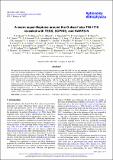A warm super-Neptune around the G-dwarf star TOI-1710 revealed with TESS, SOPHIE, and HARPS-N
Author(s)
Seager, Sara
DownloadPublished version (7.653Mb)
Publisher with Creative Commons License
Publisher with Creative Commons License
Creative Commons Attribution
Terms of use
Metadata
Show full item recordAbstract
We report the discovery and characterization of the transiting extrasolar planet TOI-1710 b. It was first identified as a promising candidate by the Transiting Exoplanet Survey Satellite. Its planetary nature was then established with SOPHIE and HARPS-N spectroscopic
observations via the radial-velocity method. The stellar parameters for the host star are derived from the spectra and a joint Markov
chain Monte-Carlo adjustment of the spectral energy distribution and evolutionary tracks of TOI-1710. A joint MCMC analysis of the
TESS light curve and the radial-velocity evolution allows us to determine the planetary system properties. From our analysis, TOI1710 b is found to be a massive warm super-Neptune (Mp = 28.3 ± 4.7 M⊕ and Rp = 5.34 ± 0.11 R⊕) orbiting a G5V dwarf star
(Teff = 5665 ± 55 K) on a nearly circular 24.3-day orbit (e = 0.16 ± 0.08). The orbital period of this planet is close to the estimated
rotation period of its host star Prot = 22.5 ± 2.0 days and it has a low Keplerian semi-amplitude K = 6.4 ± 1.0 m s−1
; we thus performed
additional analyses to show the robustness of the retrieved planetary parameters. With a low bulk density of 1.03 ± 0.23 g cm−3
and
orbiting a bright host star (J = 8.3, V = 9.6), TOI-1710 b is one of the best targets in this mass-radius range (near the Neptunian desert)
for atmospheric characterization via transmission spectroscopy, a key measurement in constraining planet formation and evolutionary
models of sub-Jovian planets.
Date issued
2022Department
Massachusetts Institute of Technology. Department of Earth, Atmospheric, and Planetary SciencesJournal
Astronomy and Astrophysics
Publisher
EDP Sciences
Citation
Seager, Sara. 2022. "A warm super-Neptune around the G-dwarf star TOI-1710 revealed with TESS, SOPHIE, and HARPS-N." Astronomy and Astrophysics, 666.
Version: Final published version